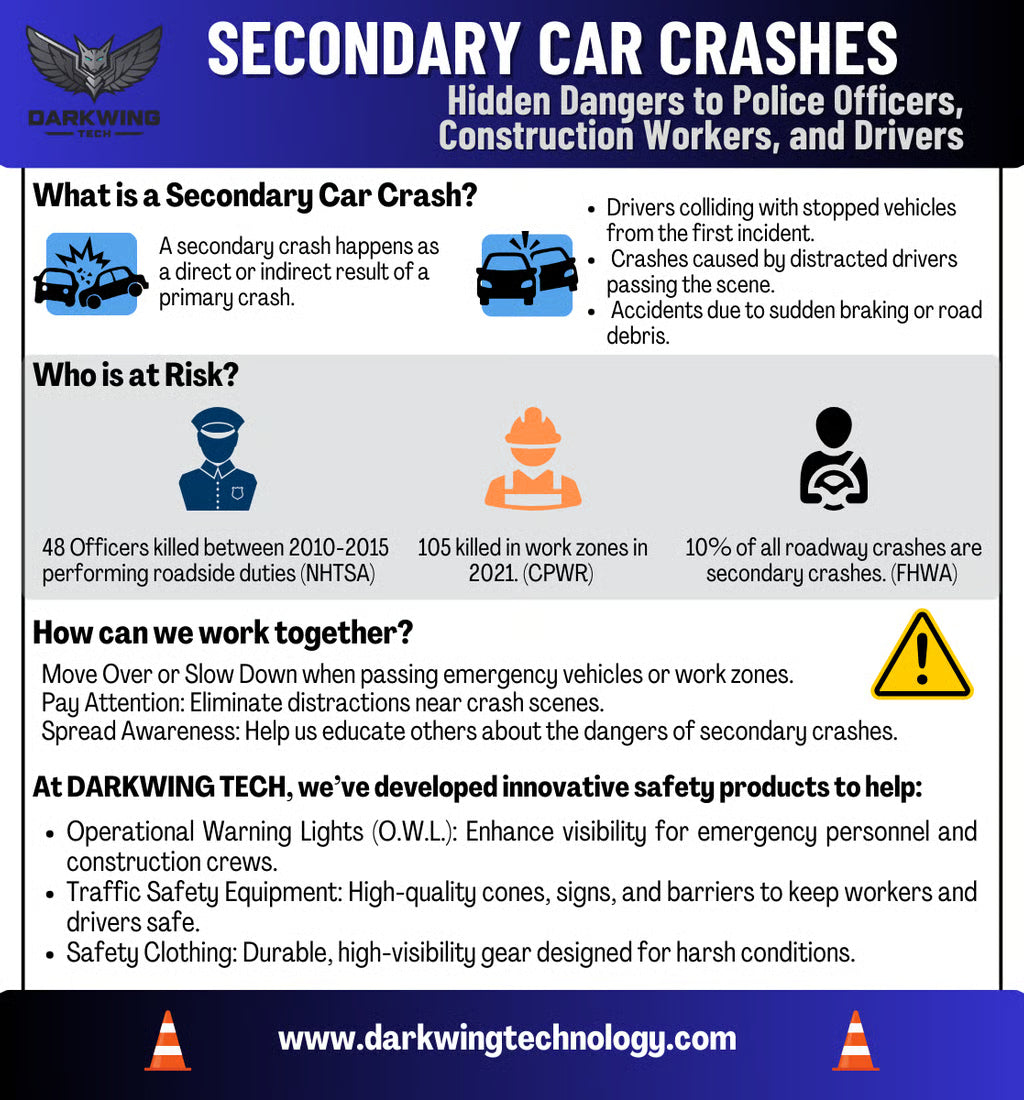
Secondary Car Crashes: Hidden Dangers to Police Officers and More
Share
Secondary Car Crashes: Hidden Dangers to Police Officers and More
What is a Secondary Car Crash?
A secondary car crash occurs as a direct or indirect result of a primary crash. These incidents can happen when:
- Drivers collide with vehicles stopped because of the initial accident.
- Distracted drivers cause accidents while passing the scene.
- Accidents occur due to debris, sudden braking, or unexpected traffic patterns.
Why Are Statistics Hard to Find?
Secondary crashes are often underreported due to a lack of standardized definitions or focus on primary crashes. Many crash reports do not categorize them separately, making it difficult to accurately measure their prevalence. This lack of clarity hides a real and persistent danger on our roadways.
Personal Perspective: A Patrol Supervisor’s Experience
As a patrol supervisor, I’ve seen firsthand the dangers that secondary car crashes pose, not just to the public but also to the emergency responders tasked with ensuring everyone’s safety. Throughout my career, I’ve responded to a thousand or so traffic accidents, both as the investigating officer and the supervisor on scene. These accidents, especially those that block traffic or alter traffic patterns, are often vulnerable to secondary crashes.
Sometimes, a “lookie-loo” or distracted driver can cause a crash even when traffic isn’t blocked. Emergency responders are put in a tough position—juggling the safety of those involved in the original accident, protecting other motorists, and conducting an investigation, often by themselves. This is when the danger sets in. I can’t tell you how many times I’ve seen secondary crashes occur at these scenes—far more than the statistics show.
Distracted drivers, who aren’t paying attention and are caught off guard as they approach the scene, are often the culprits. I’ve seen them run over traffic cones, swerve into oncoming traffic, collide with emergency vehicles, or even crash into the original accident itself. Confusion also plays a role. Many accidents happen in inconvenient or high-traffic areas, where emergency workers do their best to signal and direct traffic with the tools at their disposal. But for some motorists, certain cone arrangements, bright flashing lights, or emergency vehicle positions only add to the confusion.
Combine this with factors like speed, distractions, or poor visibility, and it creates a dangerous environment for everyone involved. Responders do the best they can with what they’re given: emergency lights, traffic cones (if provided by their departments), and hi-vis clothing. They’re like artists, creatively arranging the tools they have to channel traffic and keep people safe. But despite their best efforts, secondary crashes remain a persistent and serious threat.
Impact on Police Officers
Between 2010 and 2015, 48 officers were killed while performing roadside duties due to secondary crashes, according to the National Highway Traffic Safety Administration (NHTSA). Thousands more are injured annually.
Despite "Move Over" laws, compliance remains inconsistent. Officers find themselves facing the dual challenge of protecting the public and conducting investigations in extremely hazardous conditions.
Impact on Construction Workers
Construction zones are also high-risk areas for secondary crashes:
- 105 construction workers were killed in 2021 in work zones (CPWR).
- Drivers and passengers are 3x more likely to be killed than construction workers in these crashes (AGC).
Secondary crashes in work zones often lead to severe injuries due to high-speed traffic near stopped vehicles and reduced visibility.
Broader Issues
The Federal Highway Administration (FHWA) estimates that 10% of all roadway crashes are secondary crashes. These crashes often result in severe injuries and fatalities due to high-speed traffic in close proximity to stopped vehicles. They also cause further delays, adding to congestion and increasing the risk of additional incidents.
How Can We Combat This?
Increased visibility and advanced warning are essential starting points. There are several tools and practices that can make a significant difference:
- High-Quality Traffic Cones: Durable, reflective cones that meet federal standards are critical for ensuring visibility in all road conditions.
- Hi-Vis Clothing: Department policies should mandate the use of hi-visibility clothing during roadside incidents.
- Portable Signage and Warning Lighting: These tools provide advanced warnings to drivers, helping them anticipate and adjust to changing traffic patterns.
- Training: The most important factor is equipping officers with the knowledge to employ their equipment effectively. Departments should dedicate time in their annual training plans to teach officers best practices for traffic control under their policies and standards.
At DARKWING TECH, we are proud to offer innovative safety products like our OWL Lights and traffic safety equipment. These tools are designed to help first responders and construction workers stay visible, safe, and prepared in even the most challenging conditions.
Call to Action
Help reduce the dangers of secondary crashes by:
- Moving Over or Slowing Down when passing emergency vehicles or work zones.
- Paying Attention and avoiding distractions near crash scenes.
- Spreading Awareness about the risks of secondary crashes and how they can be prevented.
Together, we can create safer roadways for everyone.
At DARKWING TECH, safety is our mission. Explore our range of traffic safety products and tools designed to protect those on the front lines. Visit our website, www.darkwingtech.com, to learn more!